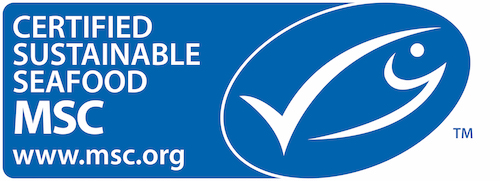Seafood harvesting and production, like any other food industry, can have a significant impact on the environment. Irresponsible fishing and aquaculture practices can lead to the decline of marine and avian species, as well as the disruption of fragile ecosystems.
The good thing is, in the U.S. and globally, there are regulations in place to help both marine ecosystems and the seafood industry flourish.
By ensuring that your seafood can be traced back to a sustainable source, you are uplifting farmers and fishermen who engage in safe, ethical, and environmentally-friendly practices!
Problems Associated with Harmful Seafood Practices
1. Overfishing
Overfishing occurs when fish are caught at a faster rate than they are able to successfully reproduce.
Ninety percent of the world’s fish populations are currently fished at, or above, their sustainable thresholds.
Larger fish are more susceptible to overfishing because of their longer life cycles but are also among the most popular seafood options.
As large fish populations decline due to overfishing, people are forced to “fish down the food web” and start relying on smaller fish species. While these fish are more plentiful, they are also a source of food for many animals, and therefore a vital component of the ecosystem.
2. Bycatch
Sea turtles, dolphins, whales, seabirds, and other marine life can become entangled in cages and nets that are intended to catch fish and shellfish. Endangered and threatened wildlife can be injured or killed as a result.
The good news is, adaptations can be made to fishing gear to protect against bycatch! The Turtle Excluder Device can be fixed to a trawling net, and allows turtles which have been caught accidentally to escape.
3. Ghost Fishing
Irresponsible fishing practices often result in the abandonment or loss of fishing equipment. Nets, cages, and lines can drift indefinitely in the ocean and continue to catch and kill hundreds of fish and other marine life.
Since fishing gear is often made up of plastic compounds, it can continue to cause damage in the environment for centuries.
4. Aquaculture Wastewater
Some fish are farmed in open water enclosures, where chemicals, food, waste, and disease can be transmitted to the natural environment and wild fish populations.
In fish ponds on land, wastewater is sometimes discharged directly into nearby natural water bodies, polluting rivers, lakes, and oceans.
5. Coastal and Seafloor Damage
Bottom trawling is one form of mass industry fishing, where a large, weighted net is dragged along the bottom of the seafloor. This practice rips up the sediment and vegetation along the seafloor, seriously impacting benthic organisms. Sediment and nutrients are redistributed or lost altogether, and the disturbance can cause haziness in the water column that interferes with photosynthetic marine organisms.
Aquaculture farms have historically been placed alongside the coast near the ocean or other bodies of water. Sometimes, construction of these farms destroys crucial coastal ecosystems, such as mangrove habitats, that are important to marine and terrestrial life.
Why Should You Care?
- 3 billion people worldwide depend on seafood as a part of their daily diet. It is not only an excellent source of protein, but is lower in saturated fat when compared to other proteins such as red meat.
- When done right, the farming and sourcing of sustainable seafood produces less greenhouse gases than the production of land-based meats, such as beef and lamb.
- Opting for sustainable seafood promotes a healthier ecosystem, but it also helps the fishing industry itself. By preventing overfishing and other unsustainable practices, you can help support a robust and diverse seafood industry for the future.
What is Sustainable Seafood?
Sustainable fishing and aquaculture incorporate practices that benefit both humans and the environment. Sustainable seafood is all about:
- Protecting marine and coastal habitat health
- Maintaining fish populations
- Reducing bycatch
- Mitigating climate change
- Guaranteeing fair working conditions and wages
- Preventing human trafficking and child labor in the seafood industry
What YOU Can Do To Help
The first step to creating change within the seafood industry is to ASK where your seafood comes from and CHOOSE to eat seafood that is certifiably sustainable.
This small change can be very meaningful!
The seafood industry depends on people to buy and consume the products. If you prioritize seafood that is sustainable, so will the supermarkets you shop at, the restaurants you eat at, and the farms and fisheries that source the food.
Here are some resources that can help you determine whether your favorite seafood is sustainable, and if it’s not, what some sustainable alternatives are:
1. Blue Check
Look for the blue check on seafood products that have been certified sustainable by the Marine Stewardship Council. This organization ensures that certified seafood products originate from healthy, well-managed stocks in order to prevent overfishing and other forms of environmental degradation.
Also, look out for the blue check on cat and dog food! We need to ensure that all seafood products we buy are sustainable, whether for us or our furry friends.

2. Seafood Watch by Monterey Bay Aquarium
Access the Monterey Bay Aquarium’s Seafood Watch search engine and consumer guides for comprehensive information about all kinds of seafood and their origins. You can download free pocket guides to carry with you when at restaurants or seafood shopping so you can identify the best seafood choices and alternatives.
3. NOAA’s Sustainable Seafood Profiles
Search NOAA’s Sustainable Seafood Profiles for up-to-date information on the status of some of the nation’s most valuable marine fish harvested in U.S. federal waters. They also have information on U.S. farmed fish that help meet our country’s growing seafood demand.
Information from NOAA, the Monterey Bay Aquarium, the Marine Stewardship Council, UNCTAD, and the World Wildlife Fund.